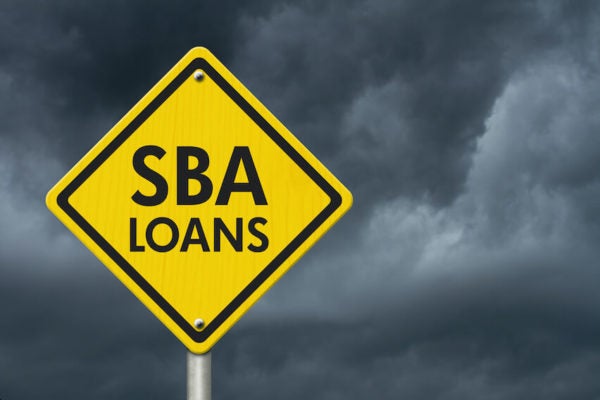Getting a small business loan can be tough, and there are so many variables to consider when looking for the right solution. Click here for a video all about working capital.

As a small business owner, you probably know access to capital and funding is one of the biggest hills to climb. A lack of capital is also one of the main reasons small businesses fail.
While there are so many variables involved in getting a small business loan, there are a few steps that can help make it a little easier and actually increase your chances of getting a small business loan.
Small business loans are designed to do two things. Help you get your business started or growing and make banks or lenders money. Both things stimulate local economic growth in their own ways and are essential parts of your small business financing strategy.
While the reasons behind small business loans are generally positive, navigating the process and understanding financing options can be intimidating. Breaking down small business loans into manageable and understandable steps can really put things into perspective.
So, read on for 7 easy steps to get a small business loan.
Table of Contents
1. Choose the Right Small Business Loan
When it comes to small business financing, lenders will always ask about the “why.” Why do you need a loan for your small business? Having that answer fleshed out is crucial for you as a small business owner, but it will also lead you to understand what type of loan you need.
There are 3 main types of business loans to focus on:
SBA Loans
An SBA (Small Business Administration) loan is a small business loan partially guaranteed by the government. This removes some of the risk for SBA lenders—the ones issuing the actual loan. Surprise! The SBA aren’t the ones doing the actual lending.
The SBA works with pre-approved financial institutions (aka traditional banks), so lending for small businesses is more frequent and comes with better terms. This is possible because the SBA partially guarantees that the lenders’ loans extend to small businesses and small business owners.
On top of better frequency and rates, SBA loans have high maximums ($5 million on regular loans, $350,000 on SBA express loans, and $500,000 on SBA export express loans)
Startup Financing Options (Business Credit Cards & Personal Loans)
There are many pros and cons to using business credit cards and personal loans to finance a small business.
Sure the convenience of credit cards is one of the most attractive features, but there are many more benefits to using credit cards beyond that. Here are some of the main advantages of using credit cards for financing:
- Retaining Equity: There’s risk involved in any business, and if you believe your business has the potential to be incredibly lucrative, you might want to retain equity for yourself. Using credit cards allows you to do what you need to with little oversight while retaining equity.
- Low-Interest Rate Offers: Yes, credit cards typically have high-interest rates however shopping around can lead to some attractive solutions. Offers like no interest on purchases for a year, or funding expenses already incurred in a business, can be very attractive short-term financing solutions. Getting a hand with fast growth in the short term can help you stay competitive.
- No Collateral: Asking a bank for a loan or line of credit often results in being asked for collateral. And if you don’t have it, securing financing can be challenging. Credit cards allow you to obtain financing without collateral.
On the flip side, there are obvious risks involved in using credit cards instead of other financing options:
- It gets personal: Using credit cards and personal loans leaves no separation between your business and personal assets. There are a few reasons this is an issue:
- It can diminish your personal credit score. Depending on the risk involved in the success of your business, you might be gambling with your personal credit score.
- You’re at risk legally if your company fails and you have to deal with accumulated credit card debt. Creditors and debt collectors can seize both company assets and personal assets to recoup what you owe.
- Past personal credit issues might prevent you from getting a credit card to finance your business.
- Low limits: As an unsecured way of financing your business, credit cards don’t always provide the high spending limits you might need to properly grow your business.
- Overextension: Spending more than you or your business can afford to pay back isn’t unique to credit cards, but it can be a bigger issue when using a credit card. With compounding interest, you can find yourself in a financial hole pretty quickly.
Business Line of Credit
Small business owners know that another big challenge when running a business is cash flow, and one of the best ways to maintain a healthy cash flow is a business line of credit.
They typically come with low-interest rates and offer the business owner flexibility to finance day-to-day operations and expenses. Growing businesses often see issues covering payroll, new equipment costs and old equipment repairs, and other unexpected expenses that can be easily managed with a business line of credit.
2. Do You Even Qualify for a Small Business Loan
You might think your finances are air-tight, and there’s no way you won’t qualify for a small business loan, but that’s not always the case. Understanding a few key requirements about small business loans and small business financing can help you understand where you stand.
What’s Your Credit Score?
Here’s a 5-second education as to why credit scores are important:
A credit score is a number between 300 and 850 that paints the picture of creditworthiness. High credit scores indicate lower risk and make a borrower look better to lenders. Your credit score is based on your credit history, which is the number of open accounts you have, your total amount of debt, what your debt repayment history has been like, and a few other factors.
Wondering what your credit score is? There are 3 main credit bureaus that will provide you with your credit score (credit report) for free: Equifax, Experian, and TransUnion. Credit card issuers and other financial websites may also provide credit score information.
Wondering what a good credit score is? A credit score between 580 and 669 is considered fair, a credit score between 670 and 739 is considered good, a credit score between 740 and 799 is considered very good, and anything over 800 is considered excellent.
Banks prefer to offer loans with competitive interest rates to borrowers with credit scores in the good range (at least above 680), but this can vary between financial institutions. Microlenders may have a higher risk tolerance for people with lower credit scores, but the trade-off will be much higher interest rates and a requirement to pay interest back sooner.
How Old is Your Business?
The rule of thumb here is as follows. Private or alternative lenders typically give small business loans to companies operating for at least a year. Some traditional banks and lenders will only provide small business loans and SBA loans if you’ve been in business for two or more years. However, if your business is a start-up with 3 months of business operations or more, you could qualify for start-up business loans.
What’s Your Revenue Look Like?
When it comes to business loans, each lender will have a different risk tolerance when it comes to your revenue and what type of loan they will give you (SBA loans, personal loans, working capital loans, etc.). Some lenders require a minimum annual revenue of anywhere between $50,000 and $250,000.
Low revenue can be a challenge at different stages of business. Options for operating with low revenue are short-term business loans, SBA microloans or even equipment financing.
3. What Monthly Payments Can You Afford?
The best small business loans will provide you with bi-weekly, monthly, or even custom payment options, but typically lenders require monthly payments.
Here are a few things to consider when reviewing your loan options and loan terms:
- Consider your cash flow and how much you can apply towards repaying your business loan or even a line of credit each month.
- Review and understand the loan terms well, as some lenders might require unexpected things like daily loan repayments.
- A safe threshold to think about when repaying your loan each month is as follows. Your total income should be at least 1.25 times the amount of your total expenses. This should include the amount you have to repay on your loan each month.
For example:
If income = $10,000 a month and expenses = $7,000 a month, your loan payment should be $1,000 a month.
$7,000 + $1,000 = $8,000 in total expenses
$8,000 x 1.25 = $10,000
Use this business loan calculator to estimate how much your loan will cost:
4. What Loan Collateral Do You Have?
There are unsecured business loans and secured business loans. Unlike unsecured business loans, secured loans require collateral, which are financial assets you own, like a building, property, or a car. These are used to pay the lender if you can’t pay back the loan.
There is a level of risk with any small business loan, but putting up collateral can increase the amount you can borrow and even lower the interest rate you pay.
Some lenders might also ask you for a personal guarantee. A personal guarantee means repayment or collateral for your business loan can be paid out from personal assets like your house, cottage or family vehicle—specifically for non-payment of the loan, of course.
5. Research Small Business Loans and Lenders
While looking for competitive interest rates or deciding between SBA loans, equipment financing, or another type of business financing, it’s important to shop around to see what small business financing options are available.
The three main types of small-business loan options are:
- Online lenders
- Banks
- Nonprofit microlenders
Each will loan funds with their own specific benefits and drawbacks, and offer multiple products that may or may not suit your business funding needs.
Using Online Lenders for Business Loans
Online lenders are a great option for getting a small business loan if you don’t have any collateral, Have been running your business for less than a year, and need fast access to working capital.
Depending on your business needs and situation, using an online lender can give you access to up to $5 million in working capital, with interest rates all over the map. Basically, the details and terms of these types of loans are unique to the lender and really depends on several aspects of your business and lending history. So, read the actual loan terms carefully.
Online lenders don’t have APRs (annual percentage rates) as low as traditional banks but typically have better approval rates and get working capital in your account faster.
The APR is an effective rate to consider when comparing loans between lenders. The APR includes the interest expense on the loan and all fees and other costs in obtaining the loan.
Using Banks for Business Loans
Banks are typically the first place small business owners go to get a loan or line of credit. When getting a loan from a bank, here are 3 things to keep in mind:
- Your business is at least 2 years old
- You have a great credit score (banks don’t like bad credit)
- You aren’t in a rush to get your money (cash flow isn’t an issue)
As briefly mentioned, the U.S. Small Business Administration provides general small-business loans (SBA loans) through banks to make it easier for small businesses to access working capital. These loans can be as high as $5 million.
Low sales volumes and cash reserves might impede your success when asking a bank for a loan. Throw in bad credit, business debt, and lack of collateral and many small business owners get turned away to seek out other small business lenders.
Working with banks can be arduous, but they usually have the lowest APR.
Using Microlenders for Business Loans
Microlenders are typically one of the last stops for many small business owners looking for a loan. They usually aren’t picky with credit score requirements, the age of your business, and can provide you with immediate cash. They are one of the best options when you can’t get a traditional loan or an SBA loan.
Microlenders are nonprofits that make short-term loans of less than $50,000 with APRs typically higher than what you’d get from a bank. To apply, you might need a detailed business plan, detailed financial statements, and a description of how the loan fits into your business plan.
Accion Opportunity Fund, Kiva and Accompany Capital are just a few examples of microlenders.
6. Get Your Ducks (Documents) In a Row
Before applying for a loan, get everything you might need in order. This includes easy access to business financials, personal financials, and much more—it can really save you time as the process of obtaining a small-business loan can be lengthy on a good day.
Depending on the lender and type of loan your business needs, you may need any of the following:
- Business and personal tax returns
- Business and personal bank statements
- Business financial statements
- Business legal documents (articles of incorporation, commercial lease, franchise agreement)
- Business plan
7. Yay, Finally Applying for a Business Loan
You turned the last corner, and the finish line is on the horizon. You know what type of loan you need and which lenders are right for you and your business. It’s finally time to fill out your small business loan application.
Your first step should be looking at two or three similar loan options. Take a look at the loan terms and APR to make it easier to compare them. Typically, choosing the one with the lowest APR makes the most sense, but reading through the loan terms is an important part of your due diligence.
The First Step Is Always the Toughest
With so much learning and consideration, getting a small business loan seems incredibly daunting. But hey, as a small business owner, you’re used to navigating daunting tasks. While getting a small business loan is a big step in the growth of your business, it really is just another step.
Learn All About Working Capital

Written by Daniel Reiter, Editor-in-Chief, FreshBooks
Posted on January 19, 2022

 U.S. COVID-19 Relief: SBA Disaster Loans
U.S. COVID-19 Relief: SBA Disaster Loans The Best U.S. Loans and Grants for Women Entrepreneurs
The Best U.S. Loans and Grants for Women Entrepreneurs Strategies for Securing a Small Business Loan in the U.S.
Strategies for Securing a Small Business Loan in the U.S.

![Starting a Business in the U.S.? A Checklist [Free Download]](https://www.freshbooks.com/blog/wp-content/uploads/2023/06/starting-a-business-checklist-hero-226x150.png)



